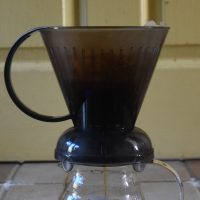 This page collates all articles that I’ve written over the history of the Coffee Spot (which has been going since 2012) featuring coffee preparation methods (which is grander than it sounds). In truth, I mostly write about coffee shops, with the occasional sideline in travel writing. However, I have written a few articles about making coffee and, with the onset COVID-19, I launched my Making Coffee at Home series, which spurred the creation of this page as a single place to bring all these articles together.
This page collates all articles that I’ve written over the history of the Coffee Spot (which has been going since 2012) featuring coffee preparation methods (which is grander than it sounds). In truth, I mostly write about coffee shops, with the occasional sideline in travel writing. However, I have written a few articles about making coffee and, with the onset COVID-19, I launched my Making Coffee at Home series, which spurred the creation of this page as a single place to bring all these articles together.
You’ll find all of the preparation methods from the Making Coffee at Home series, plus another that I wrote about the cà phê phin, the traditional Vietnamese cup-top filter. None of these articles aim to be definitive: in particular the Making Coffee at Home series are starter guides, designed to get you going with each particular method.
I’ve also included some articles that I’ve written over the years about the various coffee courses that I’ve attended. This includes a home barista course, a coffee brewing lesson and a masterclass in the cezve, one the world’s oldest coffee-making methods.
Making Coffee at Home: Cafetiere
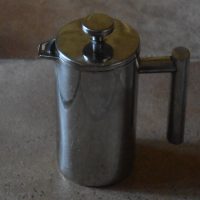 With the COVID-19 crisis in full swing, most people will be making coffee at home for the foreseeable future. While I’m rather obsessive about my home coffee making (fancy scales, hand grinder, gooseneck kettle, multiple filter methods, espresso machine...) and even have my own travelling coffee kit, that’s not for this post. Rather, I’m going back to my coffee-making roots with the method I used before I got swallowed by the speciality coffee rabbit hole. Hopefully this will help anyone not used to making coffee at home.
With the COVID-19 crisis in full swing, most people will be making coffee at home for the foreseeable future. While I’m rather obsessive about my home coffee making (fancy scales, hand grinder, gooseneck kettle, multiple filter methods, espresso machine...) and even have my own travelling coffee kit, that’s not for this post. Rather, I’m going back to my coffee-making roots with the method I used before I got swallowed by the speciality coffee rabbit hole. Hopefully this will help anyone not used to making coffee at home.
So, rather than write about my AeroPress, V60 or Clever Dripper, this post is all about the humble cafetiere (aka French Press) which I still use to make my morning coffee every day. I find it a simple, reliable and, above all, forgiving way of making coffee. It’s also very scalable: using the same basic recipe you can make coffee for one person just as easily as you can for three or four (as long as you have a big enough cafetiere, of course). All you really need is coffee, a cafetiere, mug, kettle and a timer, although the most important thing you can add is a grinder, which will improve things immensely!
Continue reading...Making Coffee at Home: AeroPress
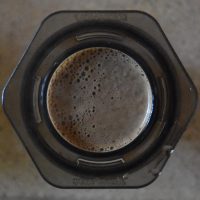 Welcome to another instalment of my Coffee at Home series (which now has its own page on the Coffee Spot). I started three weeks ago with a simple guide to the cafetiere to help (non-coffee) people who have unexpectedly found themselves at home all day due to COVID-19 make good coffee. I’ve also published articles on the importance of grinding coffee at home, as well as a guide to the Clever Dripper, another simple, reliable method. Today it’s the turn of the AeroPress, one of the coffee world’s favourite preparation methods (it’s even got its own World Championship!).
Welcome to another instalment of my Coffee at Home series (which now has its own page on the Coffee Spot). I started three weeks ago with a simple guide to the cafetiere to help (non-coffee) people who have unexpectedly found themselves at home all day due to COVID-19 make good coffee. I’ve also published articles on the importance of grinding coffee at home, as well as a guide to the Clever Dripper, another simple, reliable method. Today it’s the turn of the AeroPress, one of the coffee world’s favourite preparation methods (it’s even got its own World Championship!).
I’m a big fan of the AeroPress, so much so that I have three of them (one for home, one at my Dad’s and one that forms an integral part of my travelling coffee kit). However, it wasn’t always the case. I got my first AeroPress at the end of 2012, when I visited Leighton Buzzard’s House of Coffee, but I really didn’t get on with it. In fact, had it not been for a chance encounter at the Caffé Culture Show in May of the following year, I might have given up on it entirely. So, what changed? And why?
Continue reading...Making Coffee at Home: AeroPress (Revisited)
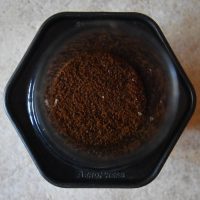 When I started my Coffee at Home series at the beginning of the COVID-19 pandemic in April 2020, the aim was to present some simple ways of improving your home coffee making. My post on the AeroPress was part of my Coffee Preparation Methods series, simple guides on how I use various coffee brewing methods. In it, I wrote about my early struggles with the AeroPress, how I came to fall in love with it, finishing with my preferred way of using the AeroPress, the inverted method.
When I started my Coffee at Home series at the beginning of the COVID-19 pandemic in April 2020, the aim was to present some simple ways of improving your home coffee making. My post on the AeroPress was part of my Coffee Preparation Methods series, simple guides on how I use various coffee brewing methods. In it, I wrote about my early struggles with the AeroPress, how I came to fall in love with it, finishing with my preferred way of using the AeroPress, the inverted method.
Fast forward six months, and, as the pandemic dragged on, I took to binge-watching James Hoffmann’s excellent You Tube channel (if you haven’t discovered it yet, I thoroughly recommend it). Since then, I’ve become an avid watcher and, along the way, I’ve learnt an awful lot. Just one example is the Clever Dripper, a method I liked but sometimes struggled with. Then along came James with his Ultimate Clever Dripper Guide and it completely changed the way I brewed with the Clever Dripper.
So, when James released his much anticipated five-part AeroPress Guide, I was intrigued. Would it confirm everything I’d been doing with my AeroPress, or turn everything on its head again?
Continue reading...Making Coffee at Home: Cafetiere Clean-up Made Easy
 The very first Making Coffee at Home post I wrote, before I even knew I’d create a whole Coffee at Home section for the Coffee Spot, was a simple guide to making better coffee with the cafetiere. To this day, for all the fancy pour-over methods I have at my disposable, or other immersion methods, such as the AeroPress or Clever Dripper, not to mention my home espresso machine, the cafetiere (or French Press), is still my go-to method for making my morning coffee.
The very first Making Coffee at Home post I wrote, before I even knew I’d create a whole Coffee at Home section for the Coffee Spot, was a simple guide to making better coffee with the cafetiere. To this day, for all the fancy pour-over methods I have at my disposable, or other immersion methods, such as the AeroPress or Clever Dripper, not to mention my home espresso machine, the cafetiere (or French Press), is still my go-to method for making my morning coffee.
One of the complaints I regularly hear about the cafetiere is that it’s difficult to clean up after a brew. This is something that I’ve never understood, since disposing of the used grounds in a cafetiere is ridiculously easy. Okay, so it’s not quite as simple as tossing a used paper pour-over filter, grounds and all, or popping an AeroPress puck into the compost, but it’s less hassle than, say, cleaning a reusable cloth filter.
So why does the cafetiere have a reputation that it’s difficult to clean up? I suspect it’s because lots of people don’t actually know how to dispose of the used grounds, so to rectify that, I’ve written this little guide.
Continue reading...Making Coffee at Home: Clever Dripper
 Two weeks ago, I launched my Coffee at Home series (which now has its own page on the Coffee Spot) with a simple guide to the cafetiere to get you started, followed by a piece on the importance of getting a grinder at home. As I explained in the cafetiere guide, it works well for bold coffees (I typically use it with espresso blends) but less well for subtle or delicate single-origins. So today I’m taking you one step further with a method that’s more suitable for those subtle/delicate single-origin coffees.
Two weeks ago, I launched my Coffee at Home series (which now has its own page on the Coffee Spot) with a simple guide to the cafetiere to get you started, followed by a piece on the importance of getting a grinder at home. As I explained in the cafetiere guide, it works well for bold coffees (I typically use it with espresso blends) but less well for subtle or delicate single-origins. So today I’m taking you one step further with a method that’s more suitable for those subtle/delicate single-origin coffees.
I’ll be honest: there are plenty of excellent filter methods out there, each with its own set of devoted fans. There’s the AeroPress, V60, Chemex and Kalita Wave to name a few. However, today I’m writing about the Clever Dripper, which, in my opinion, is the easiest method for those of you taking your next steps into home-brewing. Like the cafetiere, it doesn’t require any fancy equipment, other than the Clever Dripper itself and some filter papers. It also shares other important characteristics with the cafetiere: it’s simple, reliable and, above all, very forgiving. All you really need is coffee, a mug, kettle and a timer (plus, ideally, a grinder).
Continue reading...Making Coffee at Home: Clever Dripper (Revisited)
 One of the earliest pieces I wrote for my (then new) Coffee at Home series at the start of the COVID-19 pandemic was about the Clever Dripper. Although there are plenty of excellent filter methods, the Clever Dripper is, in my opinion, the easiest one for somebody taking their first steps into home coffee brewing. Like the humble cafetiere, it doesn’t require any fancy equipment, other than the Clever Dripper itself and some filter papers. It also shares other important characteristics with the cafetiere: it’s simple, reliable and, above all, very forgiving.
One of the earliest pieces I wrote for my (then new) Coffee at Home series at the start of the COVID-19 pandemic was about the Clever Dripper. Although there are plenty of excellent filter methods, the Clever Dripper is, in my opinion, the easiest one for somebody taking their first steps into home coffee brewing. Like the humble cafetiere, it doesn’t require any fancy equipment, other than the Clever Dripper itself and some filter papers. It also shares other important characteristics with the cafetiere: it’s simple, reliable and, above all, very forgiving.
I’ve been using my Clever Dripper throughout the last year: it’s my go-to method for filter coffee during the day, mostly for the reasons I’ve stated above. However, I’ve a confession to make: I no longer use the method I published in April last year. As regular readers will know, I’ve become a devotee of James Hoffman’s YouTube channel, and, in early December, James published his Ultimate Clever Dripper Guide. This gives a surprisingly different way of using the Clever Dripper and, having tried it, I was immediately converted. I’ve been using the new method ever since, so thought it was about time I updated my own guide.
Continue reading...Making Coffee at Home: Espresso
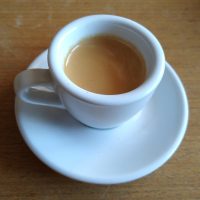 Welcome to another instalment of my Making Coffee at Home series, where I’ve left the best (hardest?) until last. After simple guides for the cafetiere, Clever Dripper, AeroPress and (not so simple) pour-over, I’ve finally turned my attention to espresso. Just to be clear, whereas for all my other guides (including pour-over to some extent), you can get decent results with minimal outlay, this is not true for espresso. If you want good espresso, you’re going to need to spend a lot of money on both a good espresso machine and a high-quality grinder (I’d say a minimum of £500).
Welcome to another instalment of my Making Coffee at Home series, where I’ve left the best (hardest?) until last. After simple guides for the cafetiere, Clever Dripper, AeroPress and (not so simple) pour-over, I’ve finally turned my attention to espresso. Just to be clear, whereas for all my other guides (including pour-over to some extent), you can get decent results with minimal outlay, this is not true for espresso. If you want good espresso, you’re going to need to spend a lot of money on both a good espresso machine and a high-quality grinder (I’d say a minimum of £500).
Now that’s not to say that you can’t made short, strong black coffee at home. You can. The AeroPress, Vietnamese cup-top filter, ibrik/cezve, moka pot and capsule machines can all make good short, strong black coffee. It’s just not going to be espresso. That said, if you’re hankering after something approaching your favourite flat white/cappuccino/latte, then you can do a reasonable job with a variety of common coffee-making equipment (see, for example, this excellent video from James Hoffman). However, what this post is all about is espresso of the sort you’d get in a good speciality coffee shop.
Continue reading...Making Coffee at Home: Moka Pot
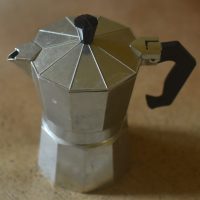 Up until now, Making Coffee at Home has focusedon brew methods which I regularly use: cafetiere, Clever Dripper, AeroPress, pour-over and espresso. Today’s post is different since I’m writing about the moka pot, something which I own, but stopped using many years ago, unhappy with the results. I moved onto other brewing methods and my moka pot has sat at the back of a shelf ever since.
Up until now, Making Coffee at Home has focusedon brew methods which I regularly use: cafetiere, Clever Dripper, AeroPress, pour-over and espresso. Today’s post is different since I’m writing about the moka pot, something which I own, but stopped using many years ago, unhappy with the results. I moved onto other brewing methods and my moka pot has sat at the back of a shelf ever since.
My interest was initially rekindled by tweets from Phil Wain (editor of Caffeine Magazine) which got me thinking that maybe I should write about the moka pot after all. I began the Making Coffee at Home series with a desire to help people make good coffee at home, particularly people who are new to making good coffee. Although I’ve tried to take you on a journey through the various preparation methods I regularly use, I know that not everyone will have the time to invest in learning a new method. Similarly, many of you won’t want to buy new coffee equipment. However, I suspect that, like me, plenty of you have a moka pot somewhere in your kitchen. So, I got my moka pot down, dusted it off and here we are...
Continue reading...Making Coffee at Home: Pour-over
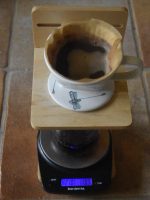 Welcome to another instalment of my Making Coffee at Home series. After a brief diversion to look at coffee itself, I’ve returned to coffee-making techniques. So far, I’ve written simple guides for the cafetiere, Clever Dripper and AeroPress. In contrast, today’s Making Coffee at Home isn’t focused on a single method. Instead, I’m looking at the broad category of pour-over filters, any device where you pour water over coffee grounds and it filters through the bottom.
Welcome to another instalment of my Making Coffee at Home series. After a brief diversion to look at coffee itself, I’ve returned to coffee-making techniques. So far, I’ve written simple guides for the cafetiere, Clever Dripper and AeroPress. In contrast, today’s Making Coffee at Home isn’t focused on a single method. Instead, I’m looking at the broad category of pour-over filters, any device where you pour water over coffee grounds and it filters through the bottom.
There are many filter devices out there, made from various materials (plastic, glass, ceramic and metal) with a wide variety of designs. Pour-over is also one of the oldest coffee-making methods: the Melitta Filter, for example, was patented in 1908, making it older than the cafetiere (1929). These days, probably the most commonly recognised are the Chemex (invented in 1941) and the much more recent Hario V60 (2004).
One of the reasons I’ve left pour-over until now is that, after espresso, it’s the method I’ve struggled with the most, giving up on it for long periods. Although you can get away with making pour-over using just a kettle, filter and filter papers, this is one method where having the extra kit really pays off.
Continue reading...Vietnamese Coffee Part III
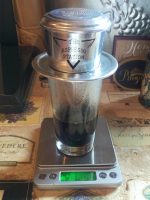 Welcome to the third and final part of my exploration of traditional Vietnamese coffee following my recent visit to Vietnam. Part I covered my introduction to Vietnamese coffee and the traditional cà phê phin, a cup-top metal filter. I explained how, after a few false starts, I discovered a taste for speciality coffee made with the cà phê phin when I tried it at Shin Coffee in Ho Chi Minh City.
Welcome to the third and final part of my exploration of traditional Vietnamese coffee following my recent visit to Vietnam. Part I covered my introduction to Vietnamese coffee and the traditional cà phê phin, a cup-top metal filter. I explained how, after a few false starts, I discovered a taste for speciality coffee made with the cà phê phin when I tried it at Shin Coffee in Ho Chi Minh City.
In Part II, I continued my exploration, trying traditional Vietnamese coffee, both speciality and non-speciality, over ice, and with condensed milk, with mixed results. I also tried the (in)famous egg coffee, traditional Vietnamese coffee with a layer of whipped egg yolk and condensed milk. Think of it as a liquid pudding rather than coffee and you’ll be fine.
In this, Part III, you can see how I got on making traditional Vietnamese coffee in various hotels and back at home using my own cà phê phin which I bought at The Espresso Station in Hoi Ann. I’ve tried a number of different beans, and used a couple of recipes which I picked up simply by observing baristas making coffee at the likes of Shin Coffee and Hanoi’s The Caffinet.
Continue reading...
Coffee Courses
As well as the articles I’ve written myself, I’ve also attended a few courses aimed at the home barista which you can read about here.
Barista Training at Department of Coffee and Social Affairs: Part I
 A fortnight ago, I was fortunate enough to be invited to attend a two-hour barista course run by the Department of Coffee and Social Affairs in Broadgate, that slightly overlooked part of London just to the north of Liverpool Street Station. The course, one of the Department’s weekly evening barista courses, was part of a week-long event called Savour Broadgate, designed to highlight the growing number of restaurants and cafés in the area, timed to coincide with the opening of Broadgate Circle, home, amongst others, of the latest branch of Beany Green.
A fortnight ago, I was fortunate enough to be invited to attend a two-hour barista course run by the Department of Coffee and Social Affairs in Broadgate, that slightly overlooked part of London just to the north of Liverpool Street Station. The course, one of the Department’s weekly evening barista courses, was part of a week-long event called Savour Broadgate, designed to highlight the growing number of restaurants and cafés in the area, timed to coincide with the opening of Broadgate Circle, home, amongst others, of the latest branch of Beany Green.
The location was the Department’s Liberty of Norton Folgate branch. If that sounds familiar, that’s because until very recently it was known as Liberty of Norton Folgate. The Department of Coffee has always been an interesting chain, each branches having its own name and distinct character. In fact, you’d often struggle to realise that some of the branches were part of the same chain. Until now, that is. The Department of Coffee has decided to brand all nine of its branches “Department of Coffee and Social Affairs”, the name coming from the Department’s very first store on Leather Lane.
Anyway, enough of the background. What about the course?
Continue reading...Barista Training at Department of Coffee and Social Affairs: Part II
 A fortnight ago, I was fortunate enough to be invited to attend a two-hour barista course run by the Department of Coffee and Social Affairs in Broadgate. It was part of a week-long event called Savour Broadgate, designed to highlight the growing number of restaurants and cafés in the Broadgate area.
A fortnight ago, I was fortunate enough to be invited to attend a two-hour barista course run by the Department of Coffee and Social Affairs in Broadgate. It was part of a week-long event called Savour Broadgate, designed to highlight the growing number of restaurants and cafés in the Broadgate area.
One thing I really appreciated about the course was just how much the two trainers, Chris and John, enjoyed themselves. These weren’t two guys going through the motions at the end of the long day. They were loving every minute of it, even my annoyingly technical questions. It was clear that they both revelled in sharing their knowledge and love of coffee and their enthusiasm was infectious.
In Part I of this Saturday Supplement, I talked about the theory aspect of the course, which was mixed with practical, hands-on examples. If you want a quick recap, we started by tasting (and understanding the taste of) espresso, before going on to learn about espresso extraction and the importance of tamping. Then, armed with all this knowledge, we were let loose on the espresso machines, first to pull some shots, then to make some flat whites.
Continue reading...Coffee with Luke: a Brewing Masterclass
 A coffee blogger’s life is a strange one. Imagine the scene: it’s the day before Christmas Eve (Christmas Eve Eve?) and you’ve got no plans. Most coffee shops are either shut or thinking of shutting. Time to put your feet up and relax before the inevitable chaos of the Coffee Spot Awards. Then your phone goes beep. It’s Luke. Do I want to attend a coffee brewing masterclass? In London. Tomorrow. Christmas Eve. Oh, go on then, you silver-tongued devil, you’ve talked me into it.
A coffee blogger’s life is a strange one. Imagine the scene: it’s the day before Christmas Eve (Christmas Eve Eve?) and you’ve got no plans. Most coffee shops are either shut or thinking of shutting. Time to put your feet up and relax before the inevitable chaos of the Coffee Spot Awards. Then your phone goes beep. It’s Luke. Do I want to attend a coffee brewing masterclass? In London. Tomorrow. Christmas Eve. Oh, go on then, you silver-tongued devil, you’ve talked me into it.
The particular Luke in question, Luke Pochron, is launching his Brewing Masterclasses, with the first one this Thursday, 28th January. What I attended was a dry run, Luke wanting to put himself through his paces with a “friendly” audience. The location was Doppio Coffee’s Warehouse in Shoreditch, an interesting combination of espresso bar, showroom and workshop on Hanbury Street, a stone’s throw from the likes of Nude Espresso.
I must confess that I approached it with a healthy dose of scepticism, considering myself pretty decent when it came to making filter coffee. An hour or so later, I left with wealth of knowledge and have since taken my coffee making up a notch or two…
Continue reading...Mastering the Cezve with Vadim Granovskiy
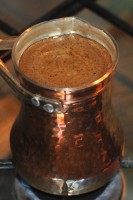 I first met Vadim Granovskiy in 2014 at a London Coffee Stops Awards event, where he gave a fascinating presentation on the ibrik, or cezve, as Vadim prefers to call it. A few days later, I had the pleasure of watching Vadim win the Ibrik Competition at the London Coffee Festival, which only confirmed my interest in this unique way of making coffee. So, when I caught up with Vadim at this year’s London Coffee Festival and he offered me a private cezve lesson, I jumped at the chance!
I first met Vadim Granovskiy in 2014 at a London Coffee Stops Awards event, where he gave a fascinating presentation on the ibrik, or cezve, as Vadim prefers to call it. A few days later, I had the pleasure of watching Vadim win the Ibrik Competition at the London Coffee Festival, which only confirmed my interest in this unique way of making coffee. So, when I caught up with Vadim at this year’s London Coffee Festival and he offered me a private cezve lesson, I jumped at the chance!
The cezve is an ancient method of making coffee, with more in common with the stove-top moka pot than espresso or modern pour-over methods. My lesson took place one evening in early May and although the focus was the cezve, it wasn’t all about making coffee. We explored the cezve itself and how to look after it, as well going on a journey of taste and perception which was every bit as fascinating as, for example, the Cimbali sensory sessions at this year’s Coffee Festival.
As well as the intensive lesson I had, Vadim also runs introductory workshops for 10-15 people. For more details, take a look at his website www.coffeeinaction.com.
Continue reading...Return to the main Coffee at Home page.
